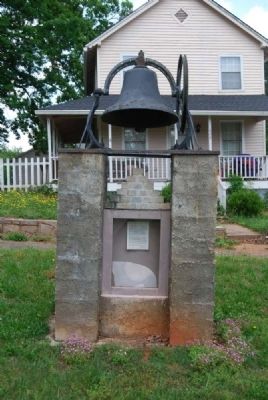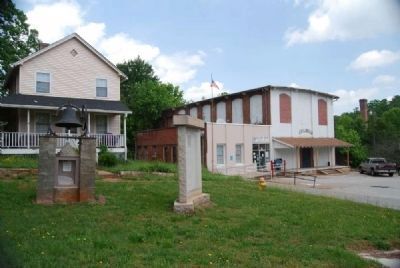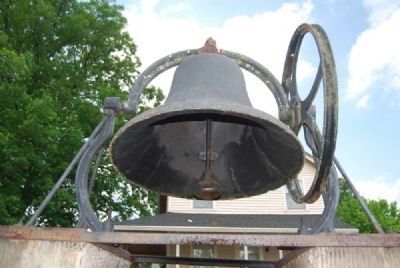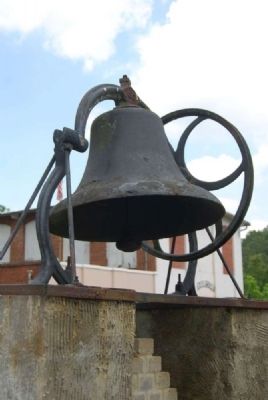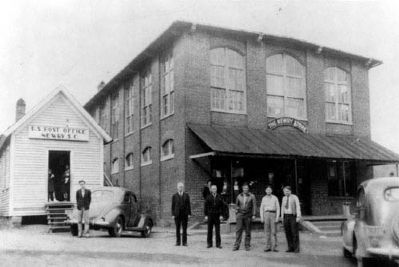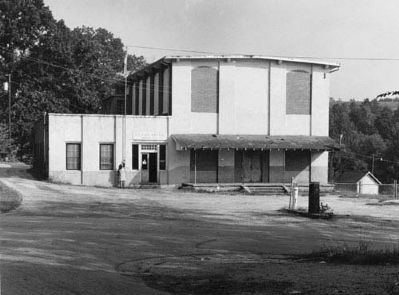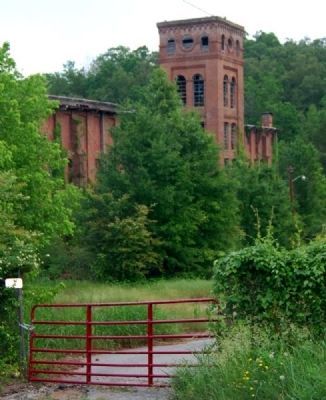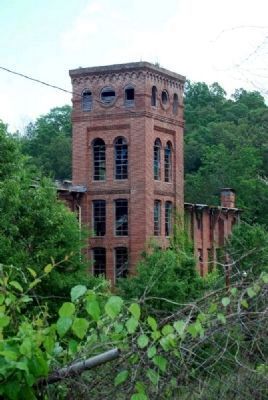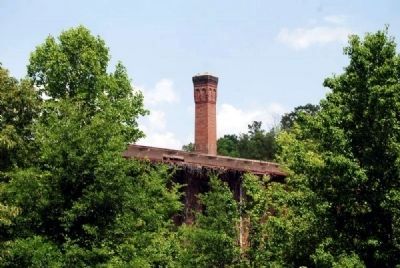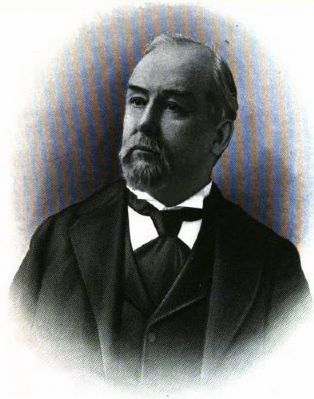Newry in Oconee County, South Carolina — The American South (South Atlantic)
The Church Bell
The citizens of Newry had been having church service in the hall over the company store for a good while after the village was built. They petitioned the company to allow them to start a building fund, which was agreed to. However, the management went two steps further. They furnished a building site near the center of the community and graciously added $1,500.00 to the meager amount the people had collected to erect the building. The people were predominately Baptist, but the church building was referred to as a Union Church, meaning that all denomination were welcome.
The above bell is the original one which faithfully served its purpose for many years. It rang not only to summon the people to worship service but it also rang on New Year's at midnight. Bells had a distinct function over a thousand years. They not only toiled for worship, they tolled for the death of saints. They tolled on ships at sea, on railway engines, on street cars, and to call farmhands in from the plantations.
However, the church bell retains a certain distinction from all others...
J.L. Gaillard, reprinted 16 June 2008
Topics and series. This historical marker is listed in this topic list: Churches & Religion. In addition, it is included in the Historic Bells series list. A significant historical date for this entry is June 16, 2008.
Location. 34° 43.517′ N, 82° 54.467′ W. Marker is in Newry, South Carolina, in Oconee County. Marker is at the intersection of Broadway Street (State Highway 37-203) and Palmetto Avenue, on the left when traveling east on Broadway Street. Touch for map. Marker is in this post office area: Newry SC 29665, United States of America. Touch for directions.
Other nearby markers. At least 10 other markers are within 4 miles of this marker, measured as the crow flies. Newry World War II Memorial (here, next to this marker); Newry Soup Kitchen (within shouting distance of this marker); Oconee County World War Veterans (approx. 3.2 miles away); Fairplay Community Veterans Memorial (approx. 3.6 miles away); Oconee County Training School (approx. 3.6 miles away); Memorial Gateway (approx. 3.7 miles away); Wall of Honor (approx. 3.7 miles away); Seneca Firsts (approx. 3.9 miles away); Seneca (approx. 3.9 miles away); Clemson University (approx. 4 miles away). Touch for a list and map of all markers in Newry.
Also see . . . Newry Historic District. The Newry Historic District encompasses a textile mill village established at the turn of the century. (Submitted on June 19, 2012, by Brian Scott of Anderson, South Carolina.)
Additional commentary.
1. A Brief History of Courtenay Manufacturing Co. and the Village of Newry
John L. Gaillard, December, 1994
I think I would be amiss to write a history of any town that was not, and suddenly became one, in one year, without recognizing the founders and the driving events that led to its existence. Anything that exists has a determined connection, and Newry's began in Charleston, SC. after a certain family, named Courtenay, chose to immigrate to America in 1791. They came from a small town called Newry on the Clanrye River in Northern Ireland. Mr. Edward Courtenay and his wife had several children, one of whom, William, born in 1831, eventua1Iy became the founding father of this little town called Newry. After his formal education,
William Courtenay became a book seller and publisher in Charleston. He later became the Head of the Business Department of The Charleston Mercury Newspaper. William Courtenay joined the militia in Charleston County early on, and as a result, was called to the defense of The Confederacy at the very beginning of the Civil War. He saw action both in Virginia and South Carolina. However with the fall of The Confederacy, he had nothing left but faith and hope. General Sherman had destroyed most of the railroads, further delaying the South's recovery. So Mr. Courtenay seized the first opportunity that came his way, which was carting raw cotton between Newberry and Orangeburg, SC. From this base he began his upward climb.
In 1865, William Courtenay
started a shipping business in Charleston. This business grew and soon had freight moving to the main ports in the Northeast and also overseas. From this venture he procured enough capital to expand beyond his shipping interests.
Mr. Courtenay entered the political arena and was elected Mayor of Charleston in 1879. He was reelected in 1883, and during his second term, was faced with the tremendous challenge of restoring the city to normalcy after the deadly earthquake of 1886. This tragedy caused the deaths of twenty-seven people, inflicted many injuries and wreaked much property damage within the city. With his, and other citizens' judicious efforts, the city soon recovered.
Mr. Courtenay later was instrumental in influencing the State Legislature to establish the State Historical Commission, which has served the citizens of South Carolina well for many years.
After his two terms as mayor of Charleston, Mr. Courtenay was ready to accept a new challenge. His experience in the shipping business made him acutely aware of the advantage of having the manufacturing process as close as possible to the raw product, hence, the idea of a textile manufacturing plant was born. He was as well aware of the topographical requirements of such a large undertaking. Taking this into account, he selected the Piedmont section of South Carolina and narrowed his choice to Oconee County with its untapped water resources flowing unhindered out of the Blue Ridge Mountains. Among other criteria he considered was the expanding rural population with its eagerness for "real pay" and more favorable living conditions. He knew that a new, clean village with more conveniences and steady pay would draw the sharecroppers like iron to a magnet. The land was available, the site was selected and the dream evolved as a reality.
On Apri1 21, 1893, Captain William A Courtenay, Frances J. Pelzer, William B. Whaley, R.C. Rhett, W.B.S. Hayward, and John C. Carey filed with the Secretary of State, J. E. Tindale, a petition that they be commissioned to form a corporation and this was immediately granted. This new corporation was issued a license to manufacture all goods of every kind pertaining to textiles-cotton, wool, and other fibers. They were permitted to perform spinning, weaving, dyeing, finishing, and the selling of all goods manufactured. An allowance to grind and mill wheat, corn and other grains, along with the making of any tools and materials deemed necessary to the construction and manufacturing process was granted. This allowance included the clearing, sawing, and finishing of timber prevalent at the site of the new village and attendant property. The charter became the birth certificate of a factory, a village, and a community that was destined to mold the lives of thousands of individuals for almost one hundred years.
So the construction of the Courtenay Manufacturing Company began in 1893. Two or three seasoned construction engineers had been brought in to oversee the project. Ground was being leveled, virgin pine and oak timber was falling and brick was being kilned, and all things directed toward the fruition of a dream were moving expeditiously. The cooperation of management and labor, along with a ready source of materials from a pristine wilderness, much like the Cherokee had left it, was becoming a factory and a village.
The mill dam on Little River was completed, the head and tail races finished, and the water wheels installed. Anticipating the installation of all the pertinent machinery. The engineers primed and activated the water wheels on June 14. 1894. With a large quantity of cotton on hand, many laborious hours were given to the completion of the spur railroad. A steam locomotive, later to be affectionately called "The Dummy" by the locals, was furnished by the R&D Railway Company.
The village was slowly taking on the character of a small town. Four eight-room houses had been built along with forty-seven six-room ones. Most were of the salt box design. Others would be built soon, along with a boarding house. Necessary out buildings were finished. A mill office was constructed, as well as the company store with a large meeting hall above and a storage building behind. Pastures were cleared, and barns were built. A village "calaboose" was erected, and a town constable was hired. All diverse elements of the village construction were speedily taking form. Soon, a schoolhouse, a church, a post office, and a barber shop would be built. The cotton gin was being erected to accommodate the local farmers and afford the plant a ready supply of cotton without the added cost of freight.
The employees were growing in number, and some were already moving into the new, comfortable houses, soon to be equipped with electricity and a water flowing sewer system. Teachers, hired for the new grammar school would teach in the community hall while the new schoolhouse was being built.
The main road, of course, had already been prepared and was in constant use. Mr. John Boggs and a Mr. Kelly were in charge of setting out elm trees on both sides of Main Street. These trees would grow to a majestic, uniform height, adding much comfort and beauty to the village.
Wells were dug and installed with iron hand pumps, but in short time, were replaced with a modem pump driven water system supplying household water and water for the sewer system. This was a tremendous improvement for the benefit of the employees in those early years.
The company store,
a village "gem" itself afforded the inhabitants a ready source of almost all their needs. If one were asked what goods were available, the answer was "Everything". With everything now in place, a unified symbiotic relationship was agreed upon between the management and the employees. Therefore, the new factory in the backwoods and the residents of the village of Newry became one in effort and purpose. The factory began its initial production in September, 1884 and even though it changed owners three or four times, it maintained steady production until May, 1975, a period of eighty-one years.
In the early years of operation, a goodly number of setbacks were experienced, causing major drops in production. Several droughts occurred, reducing the water flow through the races and depleting the effectiveness of the water wheels. But on several occasions the setbacks were caused by too much water. Early in June, 1903, a late spring freshet of enormous proportion fell on the mountains and Piedmont of South Carolina, resulting in a flood of such magnitude that was before unheard of in this part of the country. The Courtenay Plant, as most all textile plants were, was located adjacent to the river. This resulted in a major inundation of the lower levels of the plant. The water stood nine and one-half feet in the lower weave room. The warehouse was washed from its foundation, and
bales of cotton water-born downstream. Three village houses, distinctly of a lower elevation than the village proper, were victims of the flood. The tenacious efforts of management and labor soon overcame this historic calamity. Over the years high water was an occasional problem, but nothing of this magnitude would recur. Although in 1915, nature's unpredictable forces would try again, the damage was nowhere near that of 1903. Among other setbacks beyond Management's control and affecting plant production was an outbreak of small pox in 1910. This deadly disease was kept in check by bringing in some experts in this field from other areas of the state and country. The records state that with the exception of about one hundred residents, all were vaccinated with a total of almost eight hundred having participated. Another health assault, more devastating to the community than the small pox outbreak, was the widespread influenza epidemic of 1918. This scourge caused numerous deaths and much suffering. From a population of nine hundred, seven hundred were stricken; one can only imagine what a deplorable effect this bad on the production of the plant. Nevertheless this adversity was overcome, as were the others. In earlier years, Mr. William Courtenay developed medical problems and consequently moved to Columbia, SC, where he died in 1908. The Board of Directors appointed Mr. Campbell Courtenay president of the plant, a position he held until it became necessary to sell the plant in April 1920. The transaction to sell Courtenay Manufacturing was executed forthrightly, with the chief stockholders being Mr. J.W. Cannon Sr., Mr. W.L. Gassaway, and Mr. Ralph Ramseur. Mr. Cannon and Mr. Gassaway were the chief Operators of Issaquenna Mill of Central, SC. On July 29, 1920, at a meeting of the Board of Directors, the following officers representing the new owners were duly elected: Mr. W.L. Gassaway as President and Treasurer, Mr. Ralph Ramseur as vice-president and Assistant Treasurer, and Mr. V.Q. Gregory as Secretary. Mr. James M. Alexander, the plant Superintendent, remained in that position. With the addition of two new Board members, identified as Mr. J.W. Norwood of Greenville, SC. and Mr. F.J. Haywood of Kannapolis, NC, the inner operation of Courtenay Manufacturing began to take on a new direction. These changes were concomitant with the Great Stock Market Crash of 1929, leaving one to wonder whether or not a connection existed.
In December, 1929, Mr. W.L. Gassaway tendered his resignation as acting President and Treasurer with Mr. Ralph Ramseur being elected in his stead. At this time the "Great Depression" was in full sway, and curtailing and shutdowns were evident throughout the textile industry. The Newry citizens were compelled to exist on a bare minimum budget. Union organizers from the North flocked South to organize the mill workers, but without much success at Newry. Although the residents of Newry seemed to be always loyal to the management and owners, the organizers caused much unrest and lasting animosities in some of the mill villages.
With the National Recovery Act, the Wage and Hour Law, the implementation of three eight-hour shifts, and other FDR programs, the textile industry began to slowly emerge from the Depression. The people of Newry began to have greater hope for continued employment, while all these programs were being implemented. Even so, most of the individually owned plants had a nip and tuck existence throughout the rest of the 1930's.
On February 9, 1934, the Cannon Mill Interest of Kannapolis, North Carolina purchased the Courtenay Plant with all additional properties. Because of a depressed textile market and a perceived lack of demand for goods woven on the narrow 'E model' looms, Cannon opted to liquidate the plant on March 19, 1939. Operations were halted at the plant, and it, along with its properties, was offered for sale. This portended bad times for the employees and citizens of Newry. While some employees sought employment at other plants, most remained, hoping for a new owner. And soon their hopes and prayers were answered by the Abney Mills Group of Greenwood, South Carolina, which purchased the plant, the village, and hundreds of acres of the surrounding properties. Having a plan to upgrade all obsolete machinery, the progressive Abney chain began ordering the latest spinning equipment available and initiating a complete overhaul of the weave room machinery. The owners eventually had all departments moving at top speed, while turning out a quality textile product. The Management was well pleased, and the inhabitants of Newry were even more pleased. Because of Abney's effort and dedication to purpose, the employees felt more secure than ever.
The start of World War Two brought about an inflated demand for all textile products, and so the Courtenay Plant operated at breakneck speed to fulfill all orders. This pace of supplying the needs of American and Allied industry lasted until the later months of 1946, but the good market demand actually did not end until the recession of the early 1950's. These years marked the genesis onslaught of foreign imports, and by the 1980's, the on-going appeasement policy of Washington would almost guarantee a decimation into the textile industry of such a gravity the South had never known before.
But at least in the mid 1940's and throughout the 1950's, the small village of Newry would still benefit from the previous and lingering successes of the Abney textile industry. In the mid
1940's, Abney Mills began to spend many thousands of dollars to renovate and upgrade the entire village of Newry. All necessary repairs to the village domiciles were effected with new Paint jobs inside and out. Two complete bathrooms were installed in each house, and several new brick duplex houses were built with others being remodeled. Sidewalks were constructed, and all roads were upgraded with paving, curbing and drainage. Suffice it to say that the entire infrastructure and living conditions of Newry Village improved immensely in the '40's and '50's.
With this vast improvement of the village of Newry came more expenditures to increase production within the plant. Due to foreign imports and the highly competitive nature of the textile industry, Abney began revamping each department in the plant and replacing outmoded machinery. With the "Fifties" drawing to a close, Abney Management chose to sell the mill village in 1959. To this end were several contributing factors. The labor and material to maintain approximately one hundred twenty village houses were becoming progressively expensive. Also, the village responsibility having been removed, all energy and effort could be redirected toward the productivity and profitability of the manufacturing process. The sale of the village would as well provide a ready source of capital for the further modernization of the machinery. The disposing of mill villages by owner textile companies seemed to be a trend in the industry throughout the South.
In the hectic decade of the "Sixties", the textile industry was beset with OSHA regulations, civil rights laws, and environmental clean-up mandates. These new laws and regulations seemed to foretell the demise of all the old four-story, smokestack textile mills throughout the country. Not being very adaptive to the modern requirement of these federal laws, most of these mills were without sufficient cash flow to comply with the new laws and realize a reasonable profit expectation at the same time. In order to accommodate federal regulations, many plants, such as the one at Newry, effected expenditures of monies dedicated only to a lost cause.
In the early 1970's, with inflation plaguing the nation and interest rates bordering on twenty per cent, industry was reluctant to borrow money for investment. The prevailing doubt was whether or not a business could realize a profit large enough to pay interest on money borrowed. Consequently, the owners of Abney Mills decided to close the Courtenay Plant in May, 1975, and only four years later, the remaining eight plants of the Abney chain were closed. But there existed a greater ramification in the closings of these plants---a bell had tolled, signifying the end of a way of life for hundreds of thousands of textile workers throughout the South. Separated only by distance, every mill village of the past had merged with the other to form an entity, a common persona, never again to unfold the joyous experience shared in the textile community by so many generations of working people and dedicated family.
— Submitted June 19, 2012, by Brian Scott of Anderson, South Carolina.
Credits. This page was last revised on September 17, 2020. It was originally submitted on June 19, 2012, by Brian Scott of Anderson, South Carolina. This page has been viewed 910 times since then and 27 times this year. Photos: 1, 2, 3, 4, 5, 6, 7, 8, 9, 10, 11, 12. submitted on June 19, 2012, by Brian Scott of Anderson, South Carolina.
